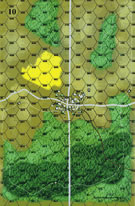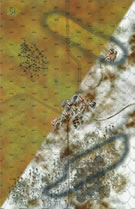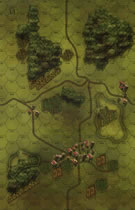|
Total |
| Side 1 |
0 |
| Draw |
0 |
| Side 2 |
0 |
|
Total |
| Side 1 |
0 |
| Draw |
0 |
| Side 2 |
0 |
|
Total |
| Side 1 |
0 |
| Draw |
0 |
| Side 2 |
0 |
| Overall Rating, 0 votes |
|---|
|
|
|
Scenario Rank:
of |
| Parent Game |
Polish Steel |
| Historicity |
Alt-History |
| Date |
1948-08-10 |
| Start Time |
12:00 |
| Turn Count |
24 |
| Visibility |
Day |
| Counters |
161 |
| Net Morale |
0 |
| Net Initiative |
2 |
| Maps |
4: 10, 2, 24, 31 |
| Layout Dimensions |
86 x 56 cm
34 x 22 in |
| Play Bounty |
255 |
| AAR Bounty |
227 |
| Total Plays |
0 |
| Total AARs |
0 |
|
Introduction
|
|
The successful defense of the Weser bridgehead meant that a drive eastward toward Poland was truly possible and not just and Allied pipe dream. The Allies therefore shifted their focus eastward with an eye to supporting the Poles. But the fastest route to Poland from the bridgehead lay along the north German coast and ran right through Hamburg, which was far too well defended for the Poles to take by themselves. That job therefore fell to the Americans, with the recently arrived US Marines attacking up the Elbe estuary while the US Army sent forces through the bridgehead to hit Hamburg from the landward side. The Poles were ordered to spend this time replenishing their strength, but they were eager to stay in the fight and knew they couldn't resume the drive eastward until the Soviet forces in Breman(on their south flank) had been driven out or encircled. Elements of I Corps therefore moved out from the bridgehead and attacked the regional hub of Osterholz-Scharmbeck north of Bremen so that US Army forces could push farther ahead and finish the encirclement of Bremen more quickly.
|
|
Conclusion
|
|
Polish valor displayed itself many times between 1939 and 1945, and more than once the crazed bravery of the Poles outweighed their generals' judgment. Polish involvement in an ill-considered offensive completely fits 1939-1945 profile, and would have been a real danger in a campaign designed to liberate occupied Poland: no Pole would with to wait a single hour.
|
Display Relevant AFV Rules
| AFV Rules Pertaining to this Scenario's Order of Battle |
- Vulnerable to results on the Assault Combat Chart (7.25, 7.63, ACC), and may be attacked by Anti-Tank fire (11.2, DFT). Anti-Tank fire only affects the individual unit fired upon (7.62, 11.0).
- AFV's are activated by tank leaders (3.2, 3.3, 5.42, 6.8).
They may also be activated as part of an initial activating stack, but if activated in this way would need a tank
leader in order to carry out combat movement.
- AFV's do not block Direct Fire (10.1).
- Full-strength AFV's with "armor efficiency" may make two anti-tank (AT) fire attacks per turn
(either in their action segment or during opportunity fire) if they have AT fire values of 0 or more
(11.2).
- Each unit with an AT fire value of 2 or more may fire at targets at a distance of between 100% and 150% of its
printed AT range. It does so at half its AT fire value. (11.3)
- Efficient and non-efficient AFV's may conduct two opportunity fires per turn if using direct fire
(7.44, 7.64).
Units with both Direct and AT Fire values may use either type of fire in the same turn as their opportunity fire,
but not both (7.22, 13.0).
Units which can take opportunity fire twice per turn do not have to target the same unit both times (13.0).
- Demoralized AFV's are not required to flee from units that do not have AT fire values (14.3).
- Place a Wreck marker when an AFV is eliminated in a bridge or town hex (16.3).
- AFV's do not benefit from Entrenchments (16.42).
- AFV's may Dig In (16.2).
- Closed-top AFV's: Immune to M, M1 and M2 results on Direct and Bombardment Fire Tables. Do not take step losses from Direct or Bombardment Fire. If X or #X result on Fire Table, make M morale check instead (7.25, 7.41, 7.61, BT, DFT).
- Closed-top AFV's: Provide the +1 modifier on the Assault Table when combined with infantry. (Modifier only applies to Germans in all scenarios; Soviet Guards in scenarios taking place after 1942; Polish, US and Commonwealth in scenarios taking place after 1943.) (ACC)
- Tank: all are closed-top and provide the +1 Assault bonus, when applicable
- Prime Movers: Transports which only transport towed units and/or leaders (May not carry personnel units). May or may not be armored (armored models are open-top). All are mechanized. (SB)
|
Soviet Union Order of Battle
| 1 Errata Item |

|
The reduced direct fire value in Kursk: Burning Tigers is 4-4.
|







 PoSt005
PoSt005 




































